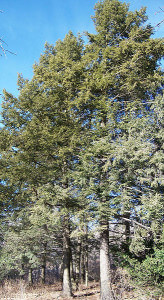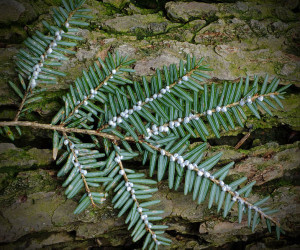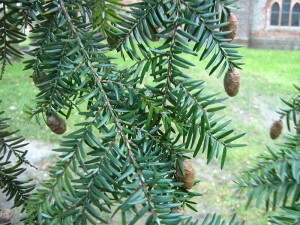
Canadian Hemlock(Tsuga canadensis), also known as Eastern Hemlock is a large forest tree native to North Eastern United States and parts of Canada. There are other species in the same genus that grow in the western part of the continent, this article generally applies to those species as well. Canadian Hemlock is an evergreen tree that can reach heights of over 100′. It is a common forest tree because it can grow well in shade and has a long life span, one specimen was recorded to be over 550 years old. Despite the fact that this is a long lived large tree it is commonly planted in rows and pruned into a tall hedge in suburban landscapes.
Edibility and Culinary Use
Although it is not a spruce tree, Canadian Hemlock has been used to make a “Spruce” flavoring for commercial products. It has a fragrance that people generally associate with evergreens such as Spruce. One of the best ways for us to enjoy this flavor is in an herbal tea. Steep the Canadian Hemlock needles or young shoots in Hot water for a few minutes. I really enjoy this tea on cold winter days. It warms you up and has a great flavor. The needles can also be added to food such as soup and stews.
Health Benefits
Canadian Hemlock was a common Native American medicinal plant. It was used for colds, kidney ailments, and joint pains. It is also an antiseptic, and can be used for gingivitis and sore throats.
Key ID Features

Canadian Hemlock is a needled evergreen tree that can grow very tall. There is at least one poisonous look a like(Genus:Taxus), and at least 2 poisonous plants with a similar name(Genus: Conium) and (Genus: Cicuta). The slightly flaky bark of the Canadian Hemlock is somewhat of a good identification feature but when identifying the needled evergreens (Spruce, Fir, Hemlock and others), looking at the needles and cones will show some of the primary distinctions. Canadian Hemlock has very small oval cones, only about .5″-1″ long. The needles are relatively small compared to other needled trees. The needles are flat with a rounded tip. Canadian Hemlock needles have a dark green top side and 2 light bluish stripes on the bottom side.

The light bluish stripes on the bottom side are important because plants in the Genus: Taxus are very poisonous and have a light green underside without stripes. Taxus needles are also somewhat larger and have pointed tips. Taxus also has a much smaller maximum height of only about 20′. Hemlock Trees(Genus: Tsuga) are the only tree in the United States to be infested with the devastating Hemlock Woolly adelgid insect, Which creates a cottony substance at the base of the needles. Not all trees, in all areas, at all times will show this substance but if you see it, then chances are you’re looking at a Canadian Hemlock.
Cautions
Do Not get the Canadian Hemlock(Tsuga canadensis) confused with the extremely lethally poisonous plants called Water Hemlock(Genus: Cicuta), or Poison Hemlock (Genus:Conium). Poison Hemlock and Water Hemlock are small biennial or perennial herbaceous plants looking similar to Carrot greens, so they look nothing like the Canadian Hemlock tree. As mentioned above a highly poisonous plant that may look like a young Canadian Hemlock to the untrained eye is the Yew Plant(Genus:Taxus). Be 100% sure that you know how to distinguish Canadian Hemlocks from Yews before you harvest.
Conclusion

Canadian Hemlock is a great addition to your medicine cabinet or pantry. On winter days if you’re feeling under the weather make some Canadian Hemlock tea. With its antiseptic properties and invigorating fragrance we can see why it was a common Native American medicinal plant and food additive for thousands of years.
Read our Article on: Safe Foraging
Many of our readers find that subscribing to Eat The Planet is the best way to make sure they don't miss any of our valuable information about wild edibles.
See our privacy policy for more information about ads on this site






